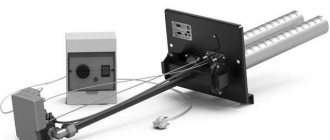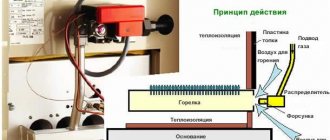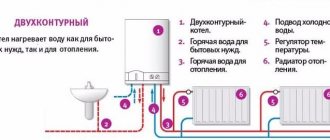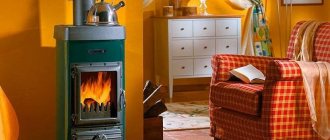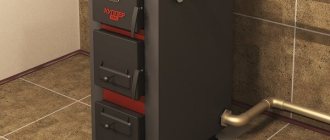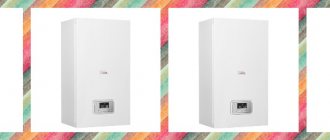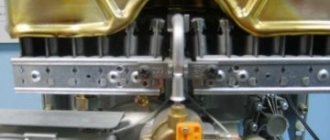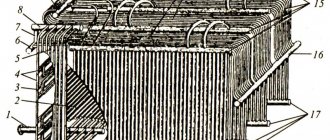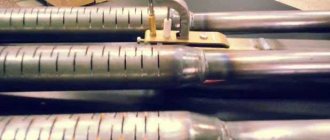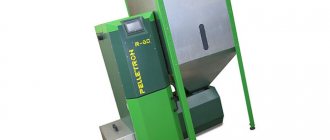Heating gas boilers have a complex structure. Their design includes combustion chambers, gas burners for boilers, and they are equipped with automation. Double-circuit equipment also includes boilers that heat water for household needs. Regardless of the brand and model of a gas boiler, its most important part is the burner. The efficiency of the entire heating system at home, as well as saving fuel resources, largely depends on it.
How to choose?
What you need to pay attention to when choosing a burner device for a boiler:
- productive power - noise level during operation (applies to supercharged models) - type of heating equipment for which the burner is purchased - type of fuel - pros and cons of this device - provide for possible malfunctions in the operation of the local gas supply line.
Taking these factors into account, you can choose the most suitable burner device for your boiler so that it operates as efficiently as possible without the burden of frequent preventative maintenance.
Variations with two stages
To arrange the operation of a two-stage burner, there are two modes or varying fire power. If using one stage the boiler operates at its maximum, then when switching to the second stage, productivity is reduced by 50-60%.
Variation of modes in boilers is carried out automatically based on a signal from special sensors. They control the temperature of the coolant. Also, modes can change when the gas pressure in the main network changes.
Switching the boiler to a less tormenting mode has certain advantages:
- There is a saving of gas or other fuel.
- All equipment develops an operational period, as the number of starts and stops decreases.
A device with two stages can have a smooth change of modes.
Combustion chamber of heating equipment
Gas boilers differ primarily in the design of the combustion chamber. It comes in two types:
- open;
- closed.
The open chamber is a fairly simple combustion device. It looks like this: above the burner there is a heat exchanger in the form of a coil of thin copper tubes. Thanks to the open design, the air required for the combustion reaction is supplied to the point of ignition of the gas from the environment.
As a rule, there is enough air from the room (provided good ventilation is organized). But there are wall-mounted models with air intake from outside, for which a special hole is mounted in the wall. Open combustion chambers require a chimney.
Most often it is installed for models of floor-standing gas boilers, and was also used to complete an old-style boiler (in this case, ignition was carried out by a pilot burner).
Combustion chamber design diagrams
The closed combustion chamber is distinguished by the design of the heating block. The heat exchanger is located above the burner. The unit body is closed, combustion air is pumped by a fan installed in the chamber. Coolant is passed through the double walls of the chamber, heating it, increasing the efficiency of the boiler. The gas is burned almost completely, the combustion products are removed by a coaxial pipe under air pressure.
Principle of operation
Portable mini-gas burners with piezo ignition can be of different designs. For some models, the cylinders may be disposable, while for others they can be removable, and still others even work with stationary ones. Many portable burners have piezo ignition to make starting a fire safe and easy. This device is mainly used for soldering copper pipes or other products made of not very refractory metal. During soldering, different solders are used - liquid or solid soldering acids.
During operation, the mixture contained therein is supplied from the cylinder: acetylene, propane or butane. The gas enters the nozzle and is ignited there. The flow of fire that has formed allows the part to be heated to the required temperature at which soldering will be possible.
A portable mini-torch with piezo ignition can be used for soldering wires, cables, pipes, copper, as well as for repairing electronics with various types of solders. It may also be useful for repairing some parts in the car (radiator and others).
But the scope of application of a device with piezo ignition is not limited to soldering of products. It can also be used in some plumbing work, during corrosion of products or during dismantling to warm up parts.
There are also some non-standard ways to use a portable device. If you like fishing, picnics or hunting, then this device may be useful to you in the field. It can be used to quickly heat up food or start a fire. Using this unit, you can quickly scorch game while hunting.
Application
The scope of use of this equipment is very wide. It can be useful for installing climate control systems, repairing cooling equipment, carrying out plumbing work and other operations. It is often necessary to use this device even when making jewelry. In these cases, one or another type of equipment may be required.
Gas burners are classified according to the following principles.
- According to the method of adjusting the flame - with a power regulator or piezo ignition.
- The nozzles are replaceable, rotating, and resemble a spear.
- According to the scope of application - equipment of a narrow focus and multifunctional.
Types of burners
According to their design and functional differences, burner devices are divided into:
By purpose:
- for high power industrial equipment
- for household equipment.
By fuel type used:
- devices for natural gas;
- devices for liquefied gas;
- universal devices.
By flame adjustment:
- single-stage – capable of operating on/off;
- two-stage (as a variation - models with smooth modulation) - operate at full power, when the desired temperature is reached, the flame is reduced by half;
- modulating - boilers with a modulating burner are characterized by smooth adjustment of the flame power.
According to the operating principle:
- injection/atmospheric. They operate by supplying air from the room. They are installed respectively in open combustion chambers. Also used for old-style boiler models.
- fan/supercharged. They work in isolated combustion chambers. Combustion air is supplied by a fan. According to their design features, they are divided into: - vortex (round-shaped nozzle holes) - direct-flow (shape of a narrow slot with a round/rectangular cross-section).
- diffuse-kenetic. Air enters two simultaneously: one is mixed with gas fuel, the second is added directly to the chamber during combustion.
Combined versions
Combined burner
When using a modulated burner, the fuel can be gas, fuel oil, or diesel fuel. Under these conditions, no technical changes to the equipment are necessary.
Options for burning different fuels have been introduced into one block. This advantage is relevant for owners who do not yet have mains gas. This option is also useful for saving fuel.
These heating burners have total automation to control the combustion mode, fire intensity and other actions of the boiler. Thanks to intelligent automation, user participation in controlling gas equipment is minimized.
True, these burners have significant shortcomings that significantly reduce their popularity:
- very complex device;
- low efficiency;
- It is a very complicated operation to reconfigure the device when changing fuel. A professional from the gas service should work here;
- colossal prices.
As already noted, burners may differ in the method of fire control.
Gas burner device for a boiler
Atmospheric and fan burner devices differ in their structure. This is due to the different ways in which oxygen is supplied to the chamber during fuel combustion.
Atmospheric burner device.
Air enters the combustion chamber directly from the room. Nozzles are located inside the burner channel. Gas is supplied to the nozzles, mixing with air, which also has access here. At a short distance from the nozzles there are outlet slots through which the finished fuel mixture is supplied. An area of reduced pressure is created between the nozzles and outlets, which promotes a constant supply of air for mixing.
A pilot burner is constantly running in the combustion chamber to ignite the main device.
Fan burner device.
The device block consists of:
- engine;
- fan;
- automatic control unit;
- gearbox;
- air pressure switch;
- fuel mixer.
Air is forced from outside by a fan and supplied to the combustion chamber to form a fuel substance. The air to gas ratio can be adjusted using a damper and a fan.
Manufacturing parameters
Before assembling the burner, you should determine in advance the required parameters, the main ones of which are:
- Flame type – torch or vortex. The design of flameless burners is too complex to make at home. The torch flame affects a small area and is used for precision welding. Using a vortex, you can quickly heat large surface areas.
- Flame adjustment device. The regulator allows you to reduce sludge and increase flow depending on the material and processing method. A water valve can be used for control.
Burner flame
One of the indicators of proper burner operation is the color of the flame. Gas equipment is characterized by an even bluish flame without admixtures of other colors. The presence of yellow or red splashes indicates that the burner is not working well, which reduces the efficiency of the heating equipment.
First of all, this applies to injection burner devices, but sometimes it is also typical for fan burners. The flame may simply lack oxygen. Also, dust and other small debris can get in with the air, which will clog the device, reducing the efficiency of the boiler. All this directly affects the flame. If it hums, the burner is loud, or the fire has changed color, you need to adjust the correct operation of the device.
Conclusion
When purchasing a boiler, you need to pay attention not only to its power and automation functionality, but also to the modification of the gas burner.
Its choice when re-equipping a heating boiler is made taking into account the size of the combustion chamber. If you do not take into account the correspondence of its dimensions to the linear parameters of the burner, burning through the metal, and in a short time, is guaranteed.
Taking into account the variety of engineering solutions and the range of devices, consulting a professional on this issue will come in handy.
In the online store alfatep.ru gas burners are presented in a large assortment. All devices are from manufacturers with an impeccable reputation. Direct deliveries allow us to keep prices low. We have experienced specialists who are ready to provide advice in choosing a burner for a specific boiler model. You can contact them by phone or through the “Feedback” option on the website. An extensive network of representative offices in the regions allows us to organize delivery of goods to the client in a short time.
In what cases is it necessary to adjust the burner flame?
An atmospheric gas burner for heating equipment often fails. It is equipped with models of both wall-mounted and floor-standing boilers. The injection burner of floor-standing equipment reduces its efficiency for various reasons:
- Burner power is too high. This happens when a high-power burner is purchased for small heating equipment. At the same time, there is not enough space for combustion, the air flow for such power is weak, which leads to the transition of the flame from blue to yellow, sooting of the combustion chamber and chimney.
- If the chimney is poorly cleaned, the boiler draft deteriorates. At the same time, waste combustion products are poorly removed, and the air flow is small. This worsens combustion and the flame turns yellow.
- A defect in the burner itself does not make it possible to correctly adjust the complete combustion of the fuel.
- Due to pressure changes in the gas supply system, well-regulated equipment can release large amounts of unexhausted gas into the chimney. Partially it settles with soot and soot. A large layer of soot reduces traction and increases fuel consumption.
- Starting heating equipment after repair.
- The presence of extraneous noise during operation of the boiler or gas burner.
- Changing the type of fuel.
You may be interested in learning about the operating principle of a double-circuit gas boiler >>>
Modulating options
Modulating multi-fuel burner
Modulating versions are characterized by the highest practicality and economy. Their work is based on smoothly controlling the burning fire. As a result, the power of the heating unit is concentrated in the range of 10 - 100%.
According to the method of flame control, these devices are divided into the following burners:
- having mechanical control technology;
- having pneumatic technology;
- versions with electronic control.
The strengths of modulated versions lie in the least cyclical on-off operations. This has a positive effect on the productivity of all heating equipment and its operating period.
Also, when work is carried out with boilers equipped with modulating gas generators, a certain fuel saving is achieved - 15%. Here it is also important to properly configure the equipment.
Modulation gas generators can be used in working boilers with this and other types of burners. This eliminates the need to replace a rather expensive unit. All you need to do is purchase the burner itself and call a specialist to install it and configure the entire technology.
Equipment setup
Floor-standing gas boilers with an atmospheric burner can be configured independently. Pressurized systems are regulated by an automatic control unit and do not require additional configuration.
Scheme of actions for setting up single-stage equipment:
- Install the device on the boiler.
- Connect to the gas pipe.
- Check for absolute tightness.
- Remove the burner housing.
- Using a pressure gauge, measure the gas pressure at the inlet.
- Connect to electricity. Make sure that the jumpers and phases are connected correctly.
- Place a gas analyzer in the chimney pipe.
- Start the device.
- Using a pressure gauge, take pressure readings at the outlet of the burner block. Pressure readings must correspond to the parameters indicated in the data sheet.
- Adjust the air flow using the air damper.
- The gas analyzer readings must also comply with all gas equipment installation standards.
Setting up gas equipment should be carried out by specialists. The simplest open-type boilers can be configured independently if you have certain skills and knowledge of the design of the burner unit. The efficiency of the boiler, its level of efficiency, and fuel consumption depend on the quality of the burner. It is possible to superficially determine that the equipment is malfunctioning by the changed burner flame.
Atmospheric GG
Atmospheric gas-flame burner
Typically, such gas burners for boilers are used in floor-standing versions of boilers. The power of these units is small: the heating potential allows heating a building with an area of up to 100 sq.m. Another type of atmospheric burner (also called turbocharged) is suitable for gas boilers, which by default are set to use natural gas. In cases of fuel change, a different version of the GG is installed. This work should be entrusted to a specialist.
In atmospheric versions, air is directed to the gas connection area in a natural way. Methods for igniting such a gas mixture: piezo ignition or electric pulse.
The design of this burner is a hollow tube with many holes or a network of tubes in which gas moves under a certain pressure.
Turbocharged burner for gas boilers, its advantages:
- reliable operation;
- simplicity of design;
- safety;
- absence of noise;
- compact parameters;
- low mass.
Homemade units
There are craftsmen who remake heating systems with their own hands. On the Internet you can even find the necessary diagrams for changing the devices of gas burners, their installation and adjustment.
Typically, metal is used as a material for the manufacture of heating systems. A cast iron firebox would be much more reliable. However, it is not possible to use it at home.
An excellent option for manual work is to order the system from specialists. They will be able to manufacture the device in accordance with all the customer’s wishes. However, the possibility of defects in the boilers cannot be ruled out, which may appear after some time.
Why do you need homemade heating units? The fact is that the marked options have a lower cost. They are made mainly because of the desire to save money. At the same time, these options are inferior to their factory counterparts in efficiency.
Over a long period of operation, it may turn out that the homemade option will be even more expensive.
Usually only solid fuel and electric units are manufactured. Making a gas or diesel boiler is extremely dangerous. In addition, their installation in the house is strictly prohibited.
According to the principle of operation, a homemade product is no different from a purchased version. It will burn fuel and heat the coolant filled with water.
The main disadvantage of this unit is the lack of warranty. Factory equipment will work and perform its functions. Even if the buyer stumbles upon a defect, he will be able to exchange the product for another.
It is better to use pellets, firewood, and coal as fuel in self-made units. These materials are less dangerous than gas. It is impossible to make heating devices based on the latter.
Simple solid fuel units are the most popular and widespread homemade devices. They are simple, and their design is in many ways similar to a conventional stove. In addition, they are versatile.
Like a conventional stove, these systems can operate on any solid fuel. The main thing is that it burns.
Main parts of a gas boiler.
The efficiency of homemade equipment is significantly lower than factory equipment. It is influenced by many factors.
Among them:
- thermal insulation;
- combustion completeness;
- the correctness of the conclusions.
The efficiency of the unit directly depends on the combustion temperature. The higher it is, the lower the efficiency. In high-quality systems, the temperature in the firebox is maintained at 120–150°C. Higher values reduce the safety of pipes. This in turn significantly reduces the durability of the unit.
When manufacturing heating boilers with a burner, it is better to protect yourself as much as possible from the possible consequences of its operation. Therefore, you should consider a separate purchase of an automatic gas burner, which will be installed in an atmospheric or blown boiler.
You can also make electric heating units with your own hands. Their design may vary. It all depends on the person’s needs. The simplest option is to install a heating element directly into the heating system. In this case, there is no need to make a boiler.
The pipe with the heater must have a sufficiently large diameter. It should be easily removable for repairs and cleaning.
Systems without a heater deserve special attention. Its role is played by water itself. A current is passed through it, and heating occurs due to the movement of water ions. The liquid itself must contain salt.
It is extremely difficult to make such a device. Electric current passes directly through the coolant, so the entire system must be reliably insulated.
One of the dangers of this device is electrical breakdown. Essentially the same as a short circuit. Gas may also accumulate in the system. As a result, heating efficiency will decrease.
From all of the above, the best option is a solid fuel unit. Its body can be assembled from heat-resistant steel. It is characterized by increased strength, less wear and high resistance to thermal influences.
However, heat-resistant steel is expensive and in practice is rarely used in homemade boilers. Another option is cast iron: this material tolerates heat well, although it is difficult to work with. Equipment for the manufacture of cast iron stoves is available only at specialized enterprises.
It is important to understand that without the proper experience and skills, it is better not to make a heating system yourself. Safety must come first. It is enough to make even one inaccuracy, and this can lead to disastrous consequences.
Features and history of creation
The first gas stove was invented back in the century before last, shortly after the general gasification in England. One of the gas factory workers named James Sharp was the first to think about using gas for cooking. It was he who, in 1825, designed the first analogue of a modern gas stove and installed it at home, significantly simplifying his life.
10 years later, factory production of such devices began, however, at first accidents often occurred, since people were not yet accustomed to the fact that gas must be handled very carefully
The period from 1837 to 1848 saw the evolution of the gas cooking appliance. The first models created by de Merle were not perfect enough. Afterwards they were improved by d'Elsner, who was an inventor. All these models still did not bear much resemblance to modern ones. But in 1857, the most advanced model of that time was invented by de Beauvoir, and it was this design that subsequently formed the basis for the creation of gas stoves for many years.
On the territory of Russia, stoves appeared only in the 30s of the last century, since mass gasification began after the revolution. However, the new devices were mainly used in apartments rather than private homes
Gas-powered units significantly saved housewives’ time, so they considered this feature a good compensation for the need for careful handling. Modern modified gas devices have a number of features
Among them there are both fairly new characteristics and those that were characteristic of all previous models.
- This unit only runs on gas. Therefore, it is necessary to either connect it to the general gas supply system, or supply fuel from a cylinder.
- A characteristic feature is the low cost of operation of this device. Even if you cook a lot, you won't have to pay a big utility bill because gas is cheap.
- A gas stove performs 3 main functions for cooking. It allows you to cook, fry and bake foods (if you have an oven).
- In most cases, the stove requires a hood, since sometimes the gas on which the device operates has a specific odor.
- A negative feature of the device is the need for extremely careful and attentive handling of it. Otherwise, there is a possibility of a gas leak, which could cause an explosion in the living space and tragic consequences.
- In the modern market of household appliances, gas stove models are presented in various embodiments.
Bottom line
Gas burners have found their application in household heating systems, as well as in industry. Gas, despite its high consumer qualities, has a fairly low cost compared to other types of fuel. This makes gas burners in demand and popular.
This review discusses the main types of gas burners, their advantages and disadvantages. This information will definitely be useful when choosing a boiler for heating, taking into account the place of its use: house, apartment, cottage.
